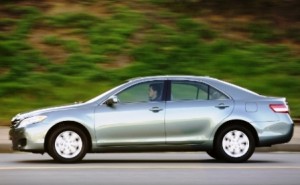
Toyota's big incentive campaign could make it #1 in the U.S. market for April - and touch off an industry-wide incentive war.
After suffering huge sales declines during the first two months of 2010, Toyota could be positioned to pull off a miraculous recovery for April, possibly even pushing past General Motors to become the nation’s top-selling automotive manufacturer for the month.
If that happens, the still-troubled Japanese maker will owe credit to some of the most lucrative incentives it has ever offered in the U.S. market, something the maker had sworn to avoid until its safety scandal sent sales tumbling.
The question is whether Toyota’s new-found fascination with rebates and other givebacks will wind up touching off the sort of profit-killing incentive war that the industry had hoped to avoid as it emerged from the most devastating downturn since the Great Depression.
“Clearly, when a major competitor pulls out all the stops (we) can’t sit idly by and watch that happen,†warns Bob Lutz, General Motors’ soon-to-retire vice chairman.
Incentives have been around as long as the auto industry itself, but they grew in significance – and size – 30 years ago, when Chrysler was struggling to avert a previous brush with bankruptcy, the automaker’s ads blaring, “Buy a car, get a check.â€Â The come-ons worked, helping the struggling maker rebuild demand, but Chrysler’s legendary Chairman Lee Iacocca soon realized how difficult it was to stop the addictive payouts, leading him to liken them to “dope.â€
“Once you start incentivizing the market, it’s been proven time and again, it becomes extremely difficult to get away from more givebacks,†says auto analyst Joe Phillippi, of AutoTrends Consulting.
General Motors learned a similar lesson in the months following the 9-11 terror attacks. Hoping to help kick-start the economy, the maker rolled out the most lucrative givebacks in industry history, but even as the market recovered, it proved difficult to cut the cash back. In the months leading up to its bankruptcy, last year, some GM products carried incentives of more than $5,000.
The Japanese maker Mitsubishi, meanwhile, was nearly broken by a so-called NINJA campaign. To lure in younger buyers, the brand targeted buyers with No assets, No Jobs or Assets, permitting them to go a full year before having to make a payment. All too many simply used the car for free, handing back the keys after 12 months.
Going into the current recession, manufacturers initially tried ramping up their givebacks but quickly realized, especially as Lehman Brothers failed, that nothing would reverse the tide. That led the industry to collective rethink the value of rebates which, says analyst George Peterson, of AutoPacific, Inc., had gobbled up tens of billions of potential profits during the preceding decade.
“Using the recession as a guide, the industry really pulled away from incentives for much of the last year,†notes Peterson.
The new strategy was to keep production in line with demand, something made easier – at least for Detroit’s makers – by the plant closings announced during the recession, as well as the bankruptcies at GM and Chrysler.
“Our plan is to bring capacity in line with demand,†said Ford’s President of the Americas, Mark Fields, “which means we can sharply cut back on all those incentives.â€
But those who hoped to eliminate incentives, or at least, more realistically, to pare them down to manageable levels, hadn’t counted on Toyota’s safety scandal. Sales plunged as the automaker added one model after another to its recall list – and then had to halt sales of eight key models during late January.
In March, bowing to demand from desperate dealers, the maker introduced a list of incentives running to more than $3,000 on some models, like the Avalon, while also offering zero-interest loans on a number of products. It was the biggest giveback campaign in Toyota history, a sharp reversal of the company’s traditional approach. If anything, Toyota typically preferred to use so-called “dealer cash,†quietly providing some money that retailers could cough up, only if absolutely necessary, to close a sale.
The strategy proved successful, however, and March sales were not only up 35% from year-earlier levels, but nearly doubled Toyota’s anemic February figures. The company told dealers it would “remain competitive,†noted sales chief Don Esmond, in a conversation with TheDetroitBureau.com. And so, while it tweaked the offerings a bit, the lucrative campaign continued in April – and is likely to go on as long as necessary.
Toyota shot past Ford, last month, to take the number two spot in the U.S. market, and preliminary indications are that it could even push past GM in April.
While Ford, Mazda and a few other makers have declined to roll out the big guns – Ford has largely focused on spot givebacks to prop up only its weakest models – other makers are going to war. Even Honda, which has turned to the so-called “triple-zero†campaign that was more common for its Detroit rivals, no interest, no down payment, no cash for the first month.
According to the industry site, Edmunds, incentives ramped up almost 5%, to an average $2,742 per vehicle, for March, and should run even higher once April figures are tallied.
Ford CEO Alan Mulally hopes to drive reason back into the market, insisting he will not “give away products and destroy profits.â€
But analysts Peterson and Phillippi, among others, believe that this strong-willed approach may be too late to restrain the industry – at least, as long as Toyota is putting lots of cash on the hood.â€
“The industry is going to have to respond,†says Phillippi, even though that could cost billions of dollars in profits manufacturers were desperately looking forward to booking in the wake of the recession.
